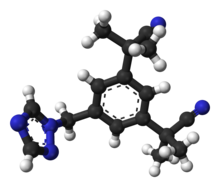Arimidex
 |
|
 |
|
| Clinical data | |
|---|---|
| Trade names | Arimidex, others |
| AHFS/Drugs.com | Monograph |
| MedlinePlus | a696018 |
| License data |
|
| Pregnancy category |
|
| Routes of administration |
By mouth (tablets) |
| ATC code | L02BG03 (WHO) |
| Legal status | |
| Legal status | |
| Pharmacokinetic data | |
| Bioavailability | 83–85% |
| Protein binding | 40% |
| Metabolism | Liver (85%) |
| Biological half-life | 46.8 h |
| Excretion | Kidney (11%) |
| Identifiers | |
|
|
| CAS Number |
120511-73-1 |
| PubChem (CID) | 2187 |
| IUPHAR/BPS | 5137 |
| DrugBank |
DB01217 |
| ChemSpider |
2102 |
| UNII |
2Z07MYW1AZ |
| KEGG |
D00960 |
| ChEBI |
CHEBI:2704 |
| ChEMBL |
CHEMBL1399 |
| ECHA InfoCard | 100.129.723 |
| Chemical and physical data | |
| Formula | C17H19N5 |
| Molar mass | 293.366 g/mol |
| 3D model (Jmol) | Interactive image |
|
|
|
|
|
|
|
Anastrozole, sold under the trade name Arimidex among others, is a medication used in addition to other treatments for breast cancer. Specifically it is used for hormone receptor-positive breast cancer. It has also been used to prevent breast cancer in those at high risk. It is taken by mouth.
Common side effects include hot flashes, altered mood, joint pain, and nausea. Severe side effects include an increased risk of heart disease and osteoporosis. Use during pregnancy is known to harm the baby. Anastrozole is in the aromatase-inhibiting family of medications. It works by blocking the creation of estrogen.
Anastrozole was patented in 1987 and approved for medical use in 1995. It is on the World Health Organization's List of Essential Medicines, the most effective and safe medicines needed in a health system. Anastrozole is available as a generic medication. The wholesale cost in the developing world is about 1.92 to 30.60 USD a month. In the United States the wholesale cost is about 3.81 USD per month.
The ATAC trial was of localized breast cancer and women received either anastrozole, tamoxifen, or both for five years, followed by five years of follow-up. After more than 5 years the group that received anastrozole had better results than the tamoxifen group. The trial suggested that anastrozole is the preferred medical therapy for postmenopausal women with localized breast cancer, which is estrogen receptor (ER) positive. Another study found that the risk of recurrence was reduced by 40%, but was associated with an increased risk of bone fractures. The study concluded that ER positive patients benefited from switching from tamoxifen to anastrozole in patients who have completed 2 years' adjuvant tamoxifen. A more recent trial found that anastrozole significantly reduced the incidence of breast cancer in postmenopausal women relative to placebo, and while there were side effects related to estrogen deprivation observed, the researchers concluded that this was probably not related to the treatment. Lead author Jack Cuzick was quoted by the BBC as saying, "This class of drugs is more effective than previous drugs such as tamoxifen and crucially, it has fewer side effects," adding that he thought there was now enough evidence to support offering the drug.
...
Wikipedia
